How to Make Pixel Art in C Visual Studio
INTRODUCTION TO PIXEL Fine art
Computer graphics and digital art every bit we know them today have a root, and that is pixel art.
Dorsum in the mean solar day, there wasn't a 'Pixel Art' style because every art made on a computer needed to be pixel-by-pixel artwork.
As computers evolved, the capability to render images became more advanced, enabling digital artists to create without the limitations of old hardware.
Creating art with these limitations in mind is the core of pixel fine art as an art form.
While no longer a necessary arroyo, forcing yourself to create in the boundaries of an sometime technology or set up of techniques tin can assist you lot every bit an
artist.
Below are some examples of my exploration with pixel art.
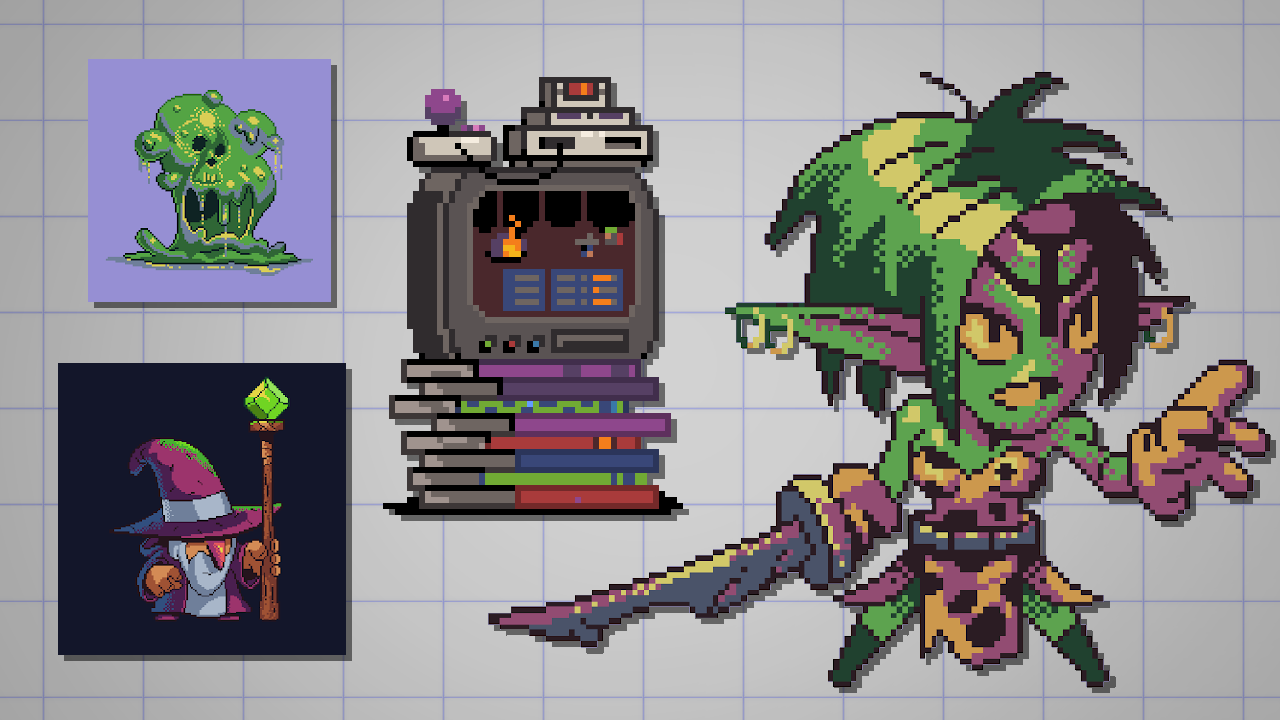
In this commodity, I'll highlight some characteristics, basic techniques and guidelines so you can start making your own pixel fine art.
All the data hither can be applied to any 'fashion' and any software. And that'south the dazzler of this subject.
The technical side of this art form is of import, specially if yous desire to make an homage of a video game.
But retrieve that you lot don't need to strength yourself to create a 32×32 pixel size artwork with simply 3 colors, if you don't want to.
Information technology'due south beneficial to respect the fundamentals and the techniques of erstwhile-school digital artists – but it's not obligatory to work similar them.
LEARNING BY DOING
For this article, nosotros'll work on an outgoing challenge.
I desire you to create a 64×64 pixel portrait.
That's it!
You can describe yourself, make a fanart or invent a character.
The goal is to create an artwork that can be used used as a social media avatar.
Start with a minor (resolution) file size, then the pixel unit is visible. In that location's no point to making pixel art where the pixels aren't evident.
SETTING UP YOUR Sail
For this commodity, I'll be using Clip Studio Paint.
While at that place's great dedicated tools for making pixel art, you can use any drawing program to follow along.
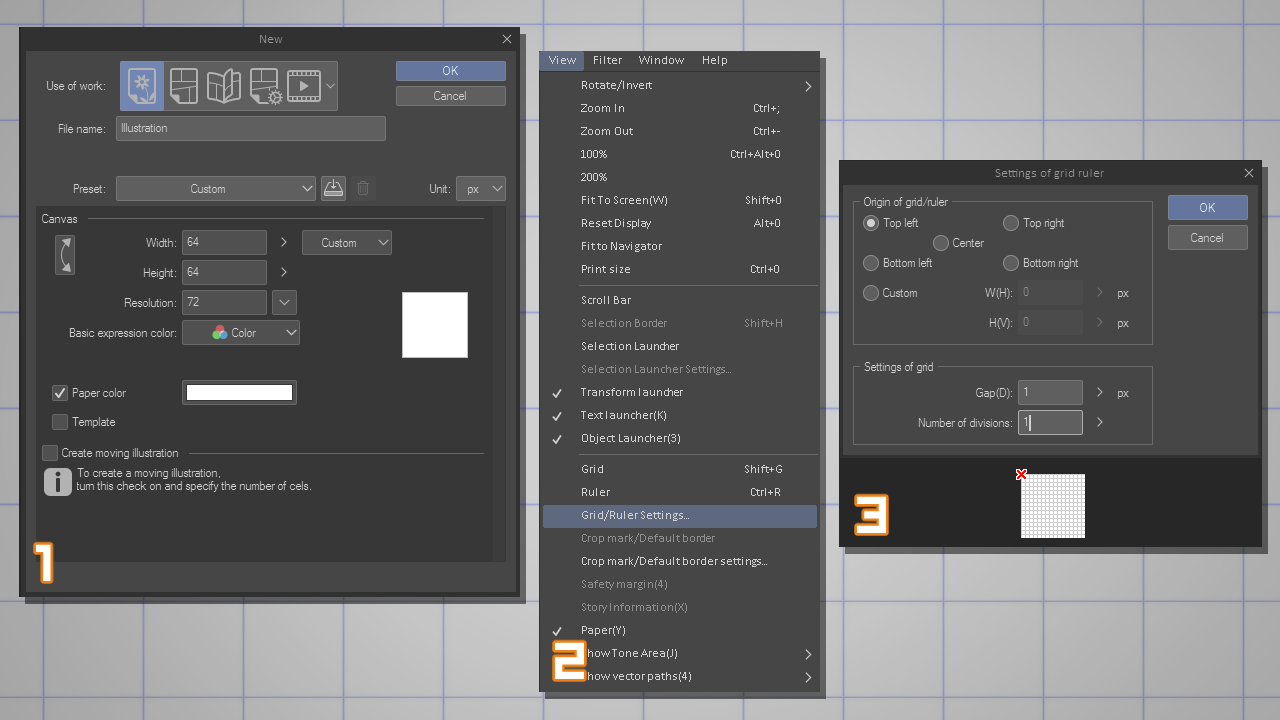
- Create a 64×64 pixel document (1);
- Get to View > Grid/Ruler Settings (2);
- Configure every bit the following and then yous tin can run across a filigree with every single pixel. You can turn the filigree on/off anytime using the Shift+1000 shortcut. (3);
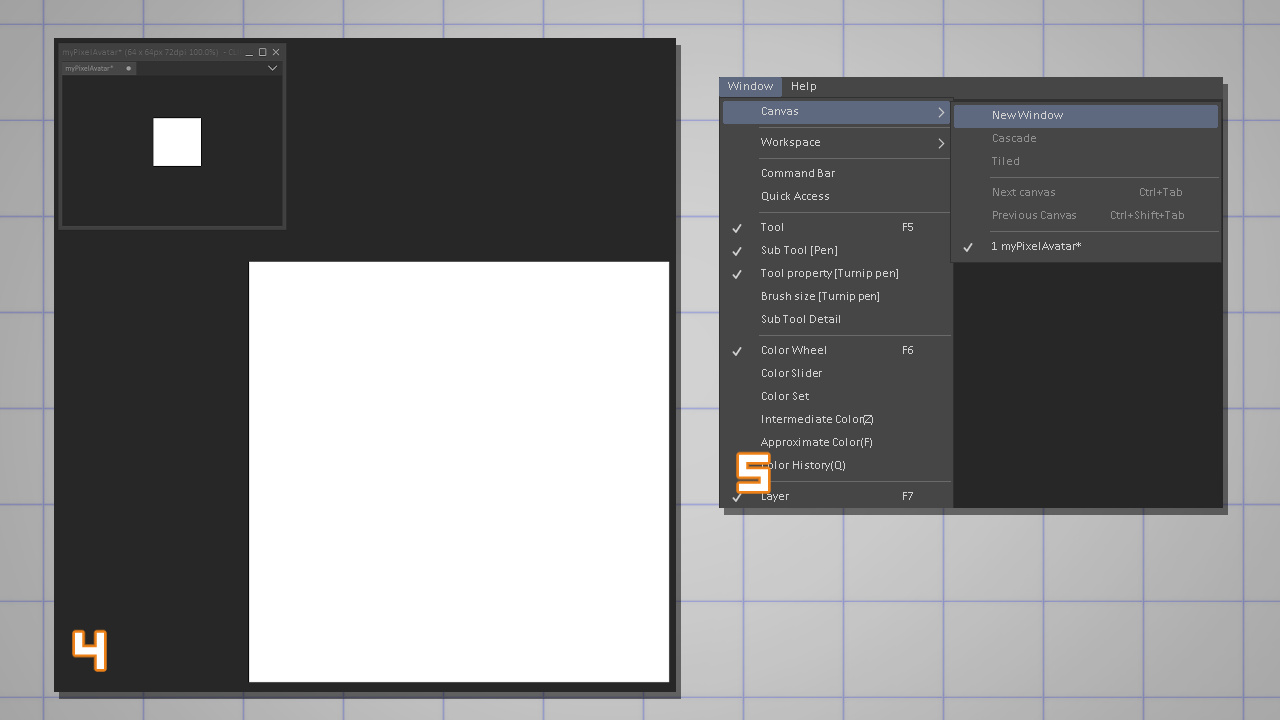
A proficient do for working with pixel fine art is getting used to drawing zoomed while keeping an heart on the actual-size artwork (4);
To create a secondary view of your current sail, become to Window > Sail > New Window and open a new instance of the current canvas.
Fix it to 100% and place in your workspace (5).
CREATING THE PIXEL ART TOOLS
Time to introduce a basic concept.
Pixel fine art does non go along with automatic anti-aliasing.
Anti-aliasing is a useful algorithm that smooths edges of a shape.
This is made by adding an extra row of pixels closest to the aliased border.
Equally you can see in the example, the anti-aliased edge (7) has an automatic gradient of pixels to give the shape a smoother contour.
The aliased edge (6) is what we're looking for when creating pixel fine art. Later, we tin soften the edges by calculation anti-aliasing past hand (manually).
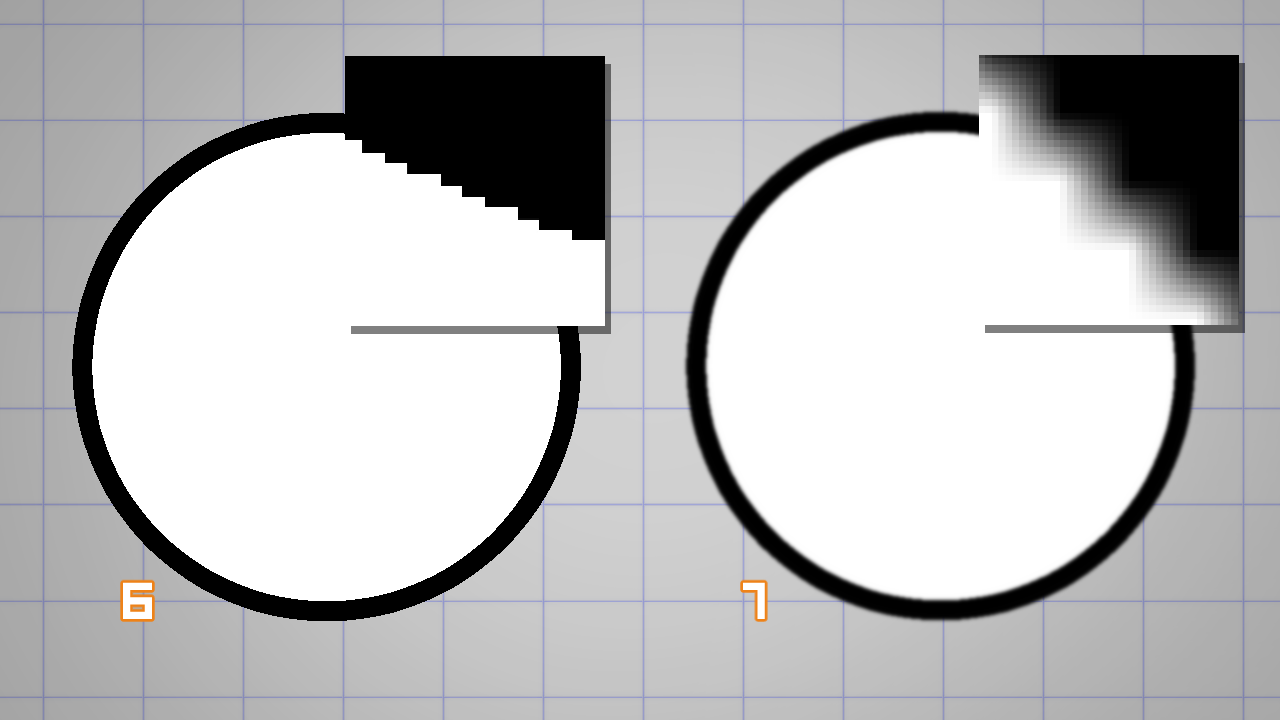
A rule-of-thumb when using whatever software to create pixel art is to disable the anti-aliasing setting in brushes, tools and transformations.
In Clip Studio Paint you have to turn off anti-aliasing in:
- brushes (eight);
- tools like Choice, Fill, Text, eg. (9);
- and during whatsoever transformation using Edit > Transform (10);
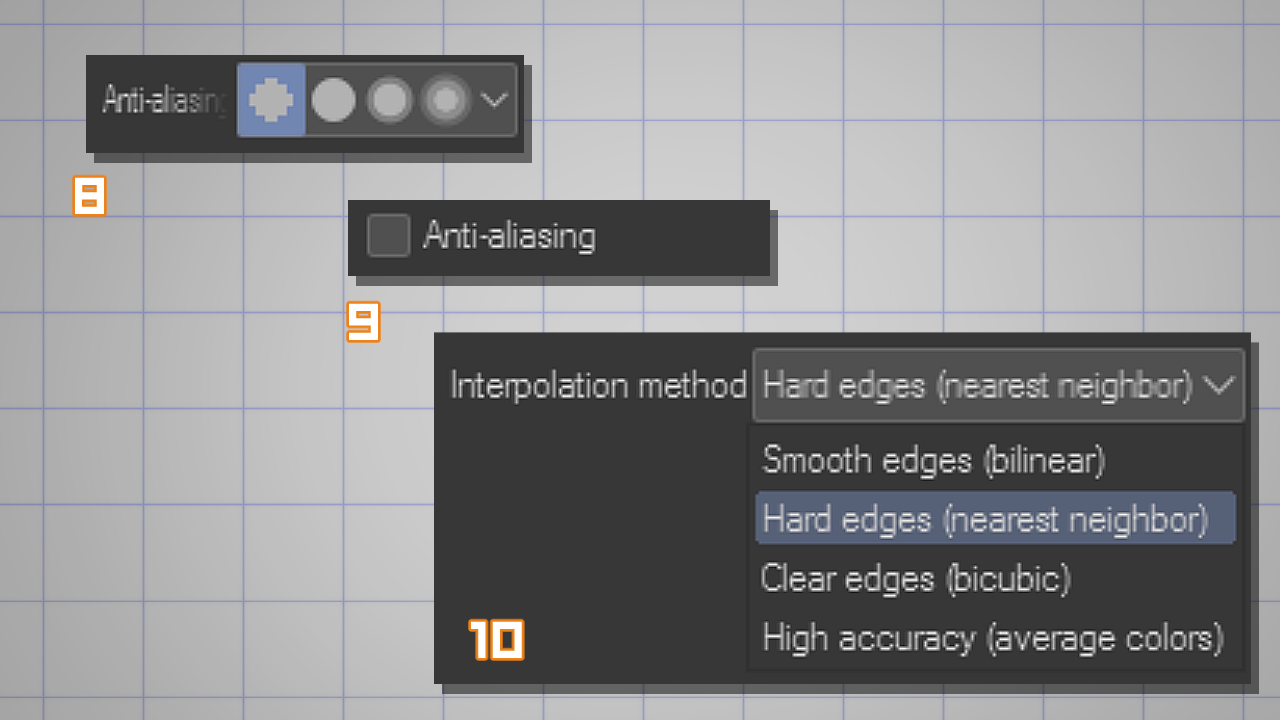
In Clip Studio Paint you already have a pixel art pen. Information technology's called 'Dot Pen' in the Mark category (xi).
This is the simplest cartoon castor available. Information technology has a fixed i-pixel size, anti-aliasing turned off, and no choice for stabilization or color mixing.
I suggest you follow along this tutorial using this brush only.
Later on in the game, yous can duplicate whatsoever of your 'mutual' brushes and use information technology for pixel art (as long you reduce brush size to lower values and disable anti-aliasing).
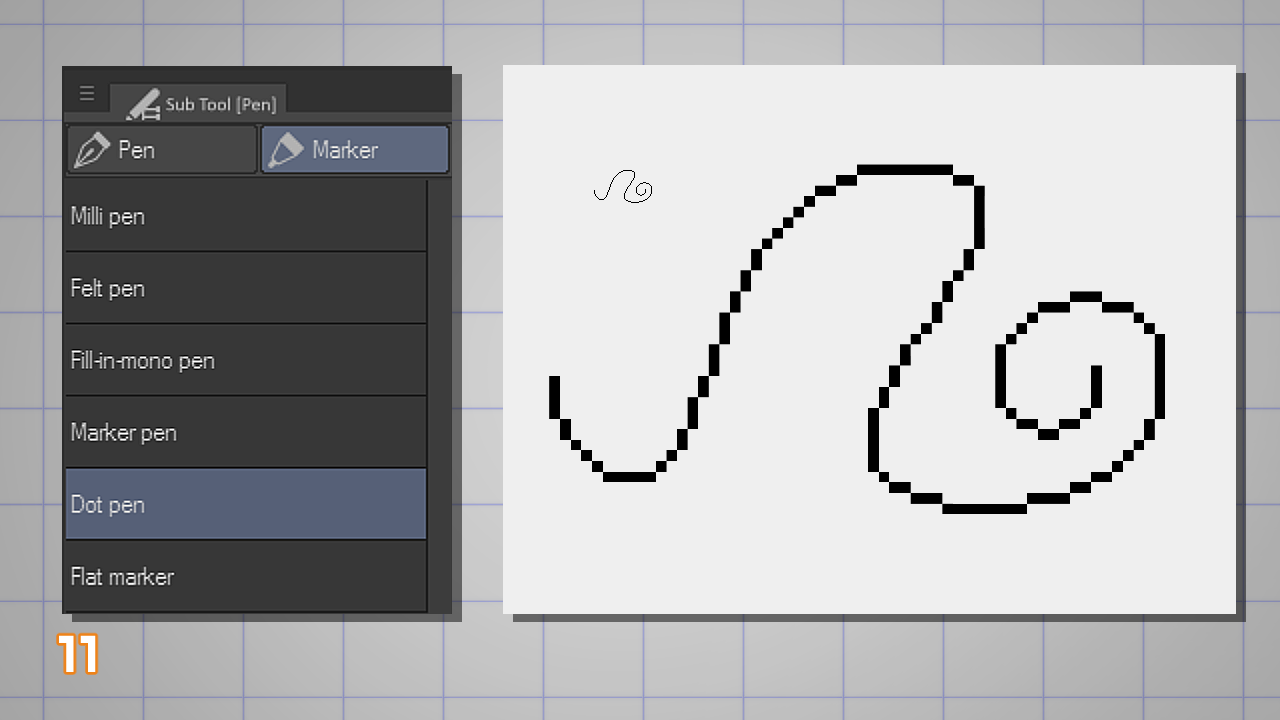
Cartoon THE LINEART
Since this will be a front-facing portrait, I'll beginning the drawing using the Symmetrical Ruler (12);
Place the Symmetrical Ruler on the Canvas and, to make sure it'southward on the dead-heart, utilise the Object tool to select information technology and input values manually (13);
In this case I inverse the Center 10 and Eye Y values to 32, which is half of my total sail size (64 pixels).
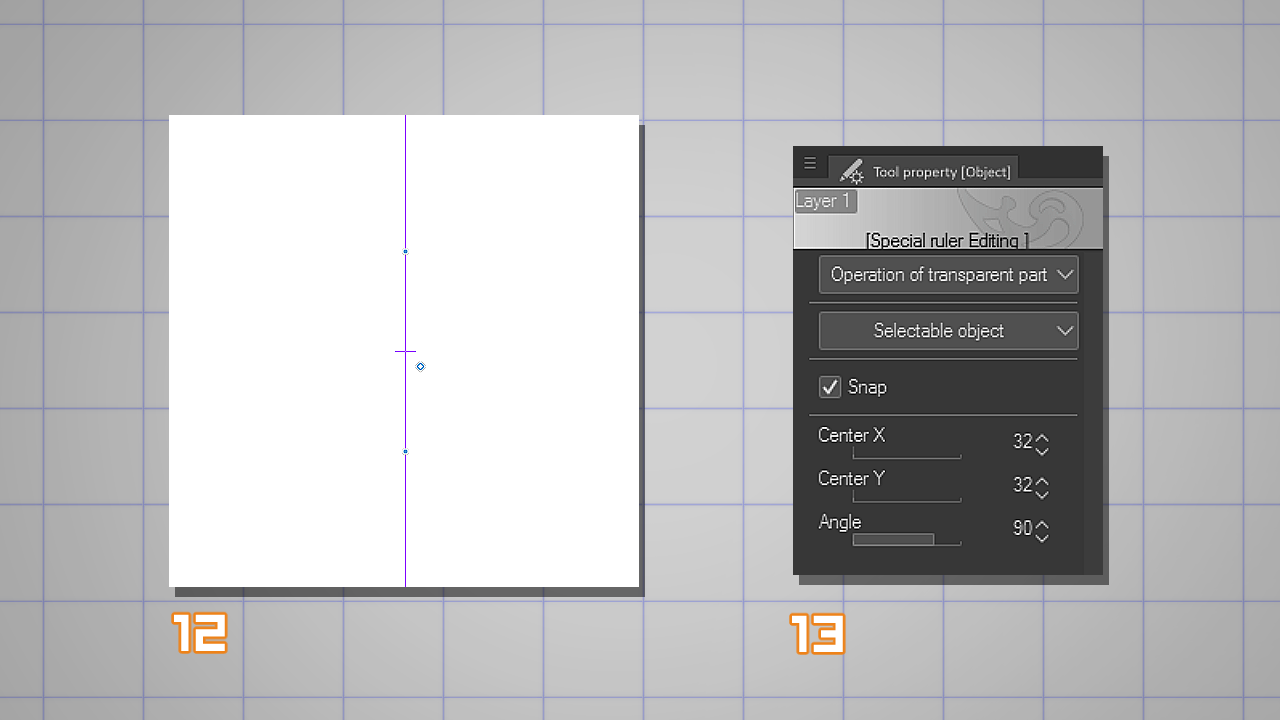
Now, select your Dot Pen once more and starting time drawing.
Since this brush tin't be resized, it's a good idea to zoom in on the canvas yous're drawing (15) and use the duplicate view every bit a reference (14).
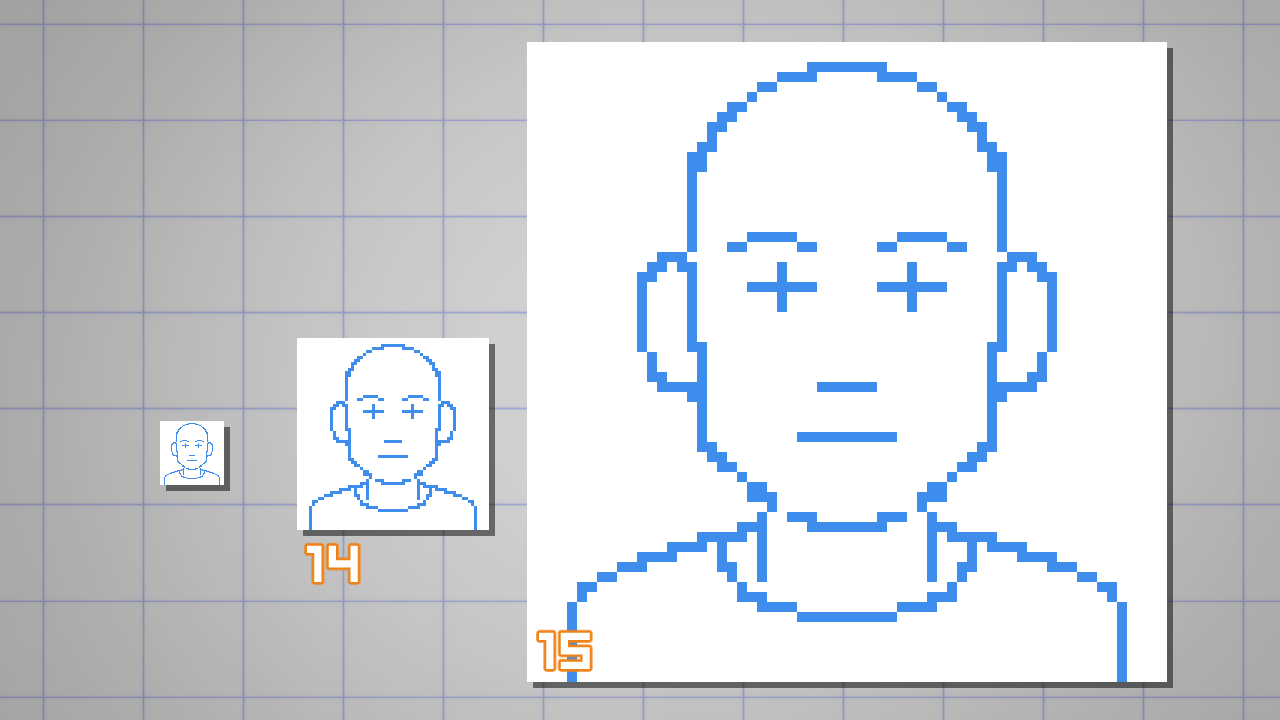
I started my portrait drawing a initial sketch to find the structure of the head (xvi) and then I started adding details (17).
There's no need to use a blue color. I just prefer it because it helps my brain understand that I'm creating a rough for my terminal drawing.
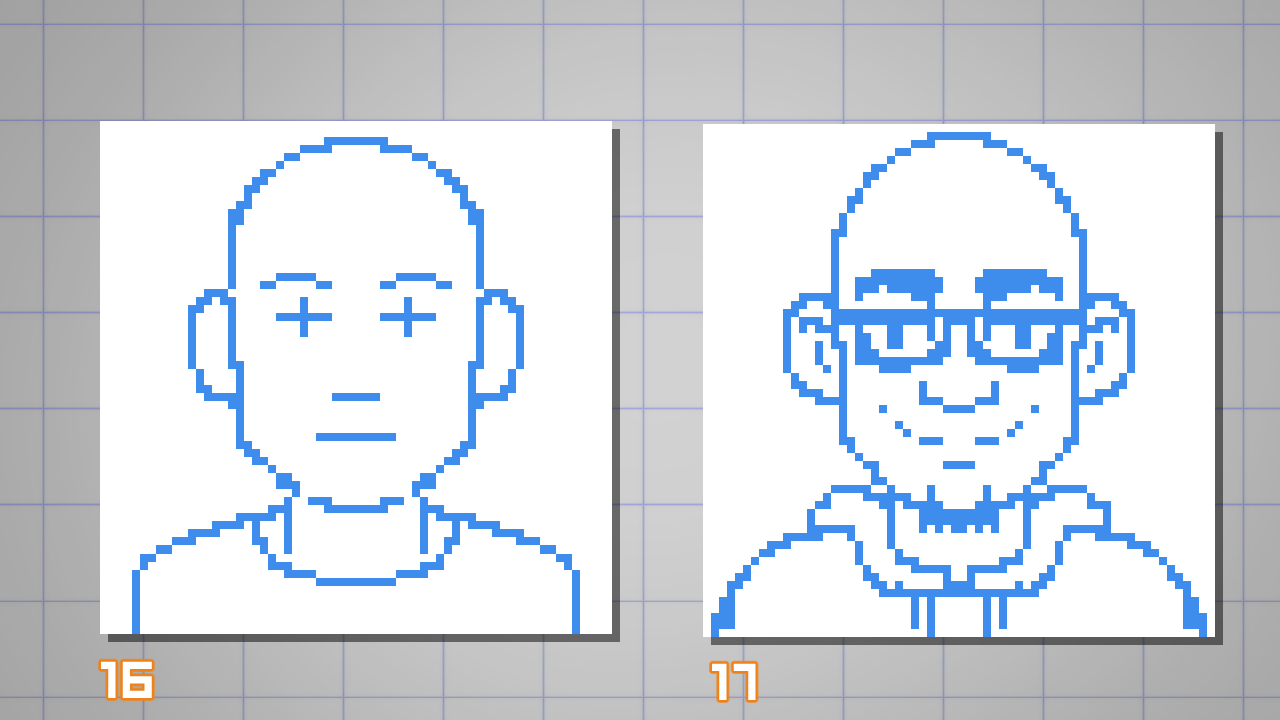
If you're done with the sketch y'all tin go on with the linework.
Before adding the last lines, allow me evidence you a simple technique for drawing lines and curves in pixel art.
In the example below, the linework (18) doesn't expect smooth because there's a lot of duplicated pixels where information technology should be a single pixel line.
Yous tin fix those 'doubles' (it'due south a term) by removing any adjacent pixels on the curve. In the example (19), I removed all pixels marked in blood-red.
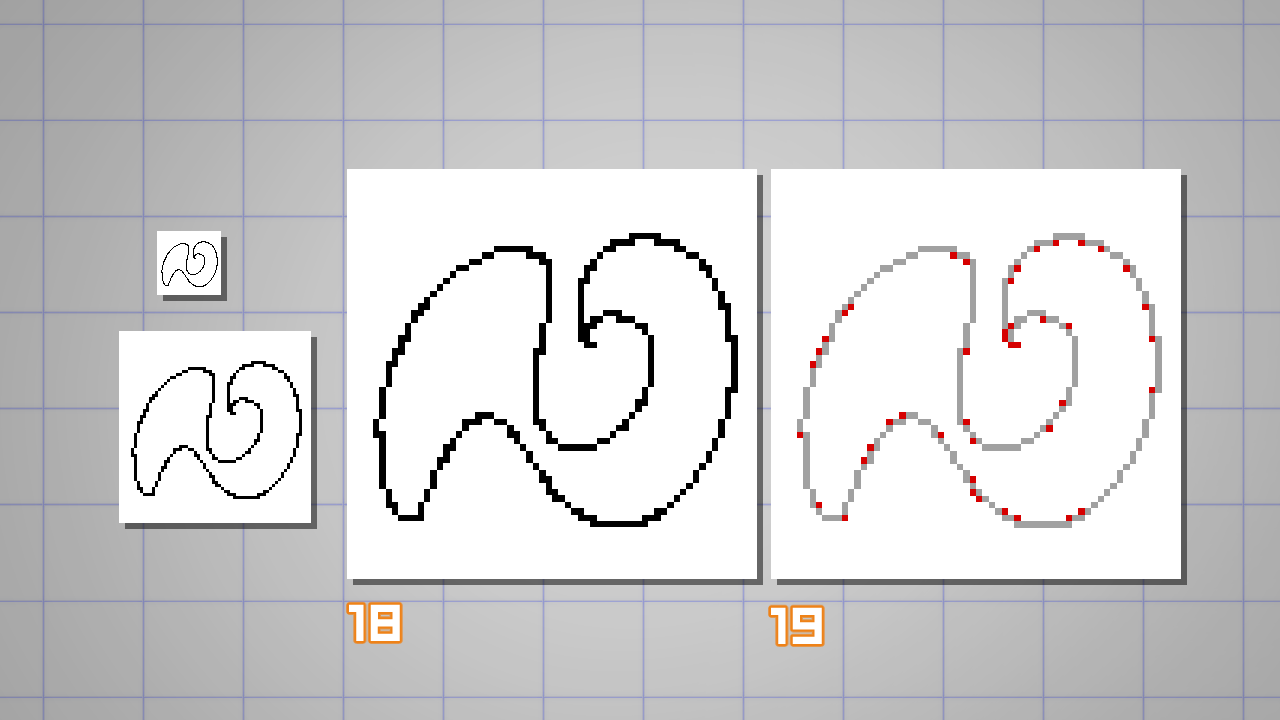
I advise you to return to your sketch and look out for those 'doubles' to clean your linework.
Exercise not worry if the curves don't feel right. Just remove the unwanted pixels.
TIP: if yous need to erase a pixel, you can simply switch to the transparent color (I accept my shortcut set to 10);
In the instance beneath you lot can see the difference of the initial sketch (xx) and the cleaned-upwardly version (21).
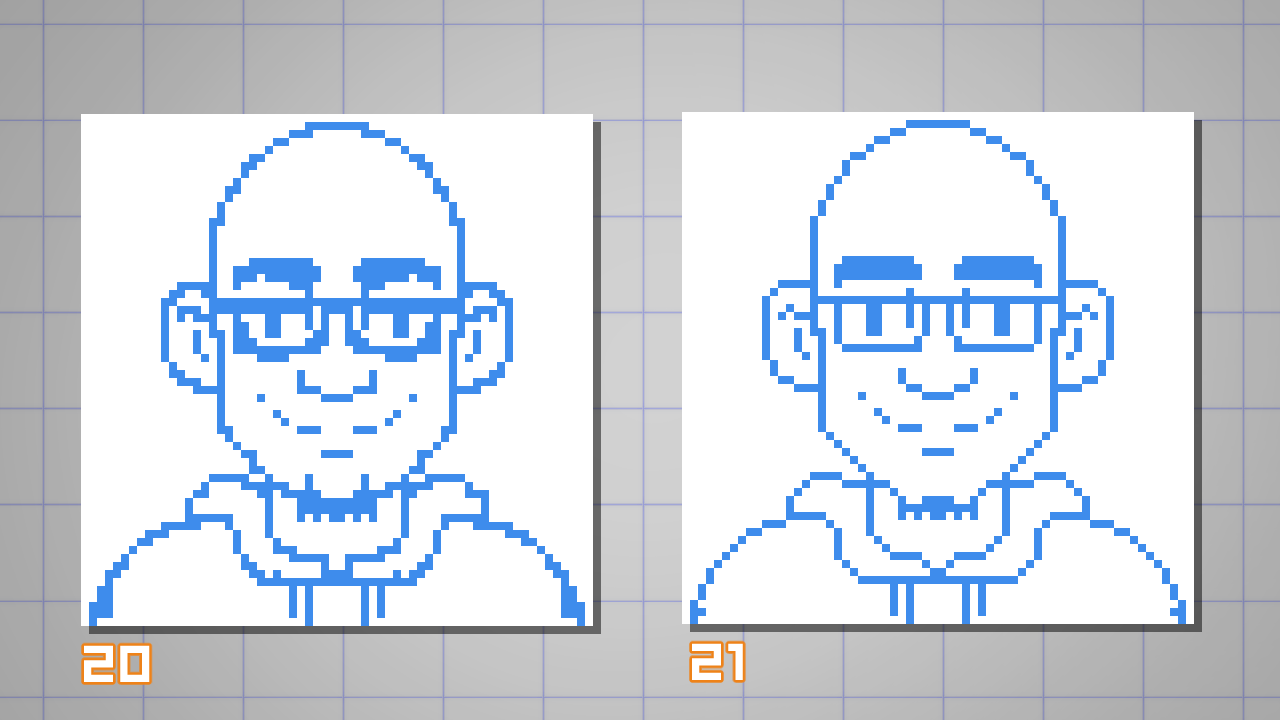
Gear up for another technique?
Let'south starting time fixing the drawing and adjusting some curves.
Seeing the example below (22), you can find the distribution and spacing of pixels are not post-obit a logical progression. (eg.: 3, ii, ane, 4…)
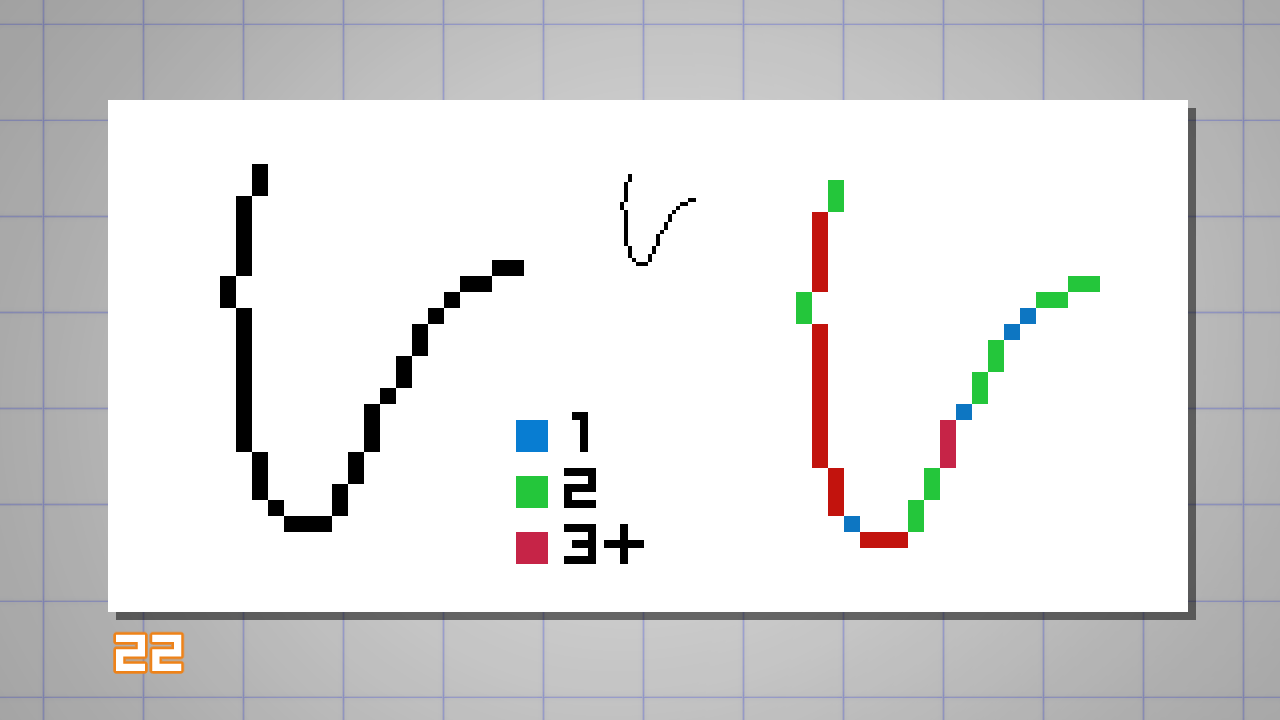
While on this improved version (23), you can see a better progression of pixels to create the curve. (eg.: ane, 2, 2, 3…)
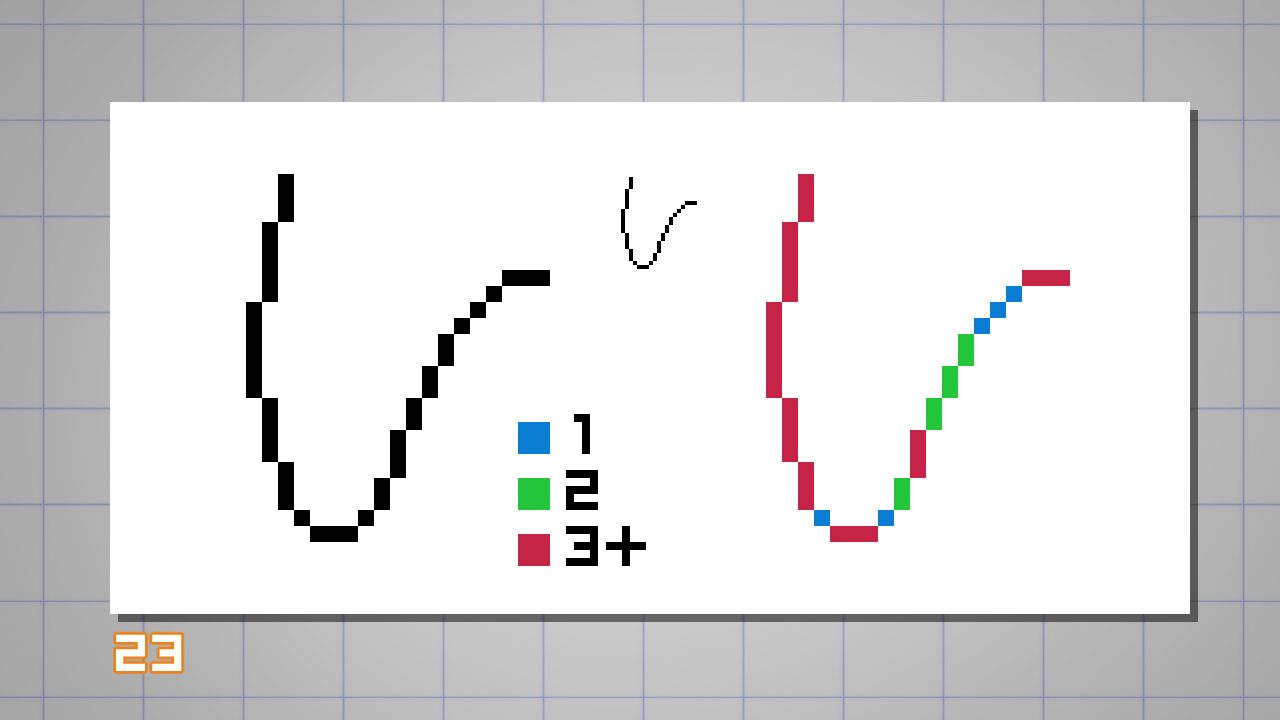
With that cognition, I suggest you to effort the following exercise before continuing on your drawing:
Try to draw some random lines and curves with the ii concepts you just learned so far: remove the doubles and maintaining the 'pixel progression'.
This will give you a solid gasp in how to contour shapes in pixel fine art.
Below is my final linework (25).
I did some small-scale adjustments on the proportions and curves, and removed some unnecessary pixels to brand the face up more readable.
Take some time to compare with the original version (24) and try to notice where I applied the techniques.
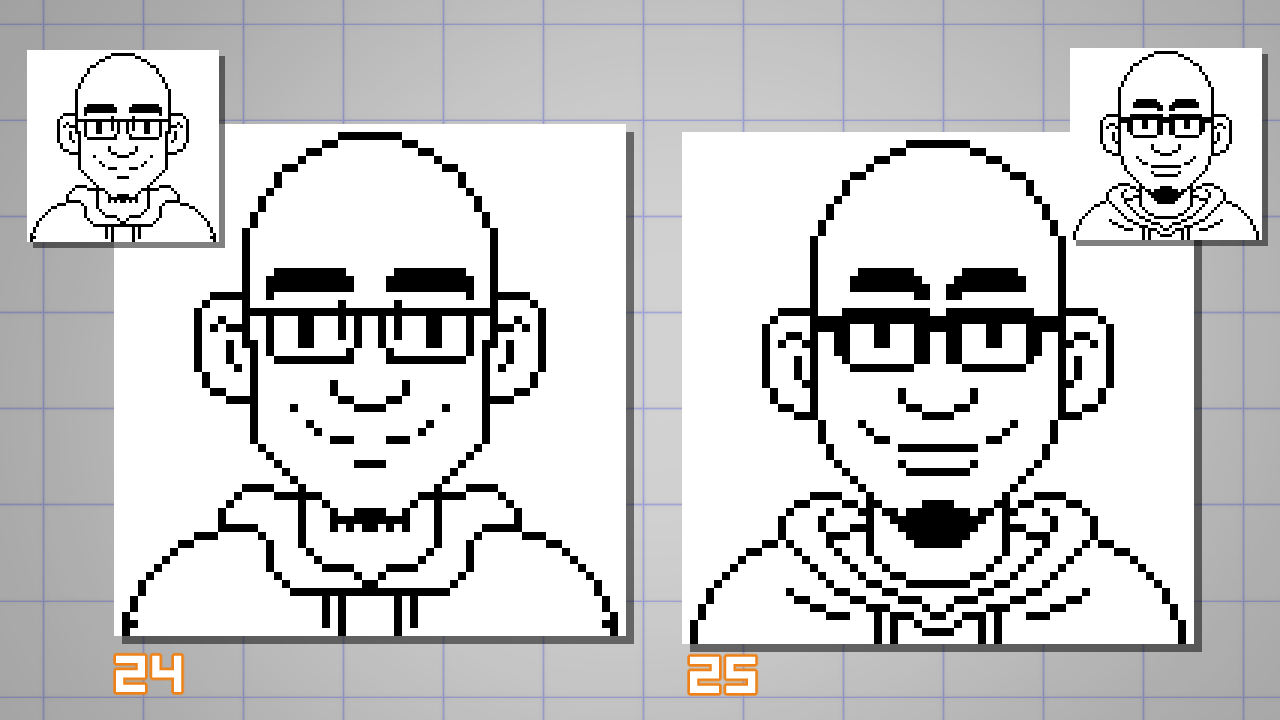
COLORING TIME
The number of colors used on a sprite (term used to draw an object in game development), depends by how much y'all want to stay close to a specific limitation of an old technology.
While not necessary, you can acquire a lot nearly pixel art by limiting yourself to a pocket-sized corporeality of colors to choose.
For at present I suggest you start with a elementary color palette. As a starting bespeak, you lot can use the 56 colors of the palette used by the NES (Nintendo Amusement Arrangement) videogame console (26).
The color and tone choices on this palette are not perfect, merely information technology provides a adept starting indicate.
In the examples below you accept the PC-98 computer color palette (27) and a personal 1 I built in the past (28);
Later yous tin start building your ain palette, but always remember to keep it tight and simple.
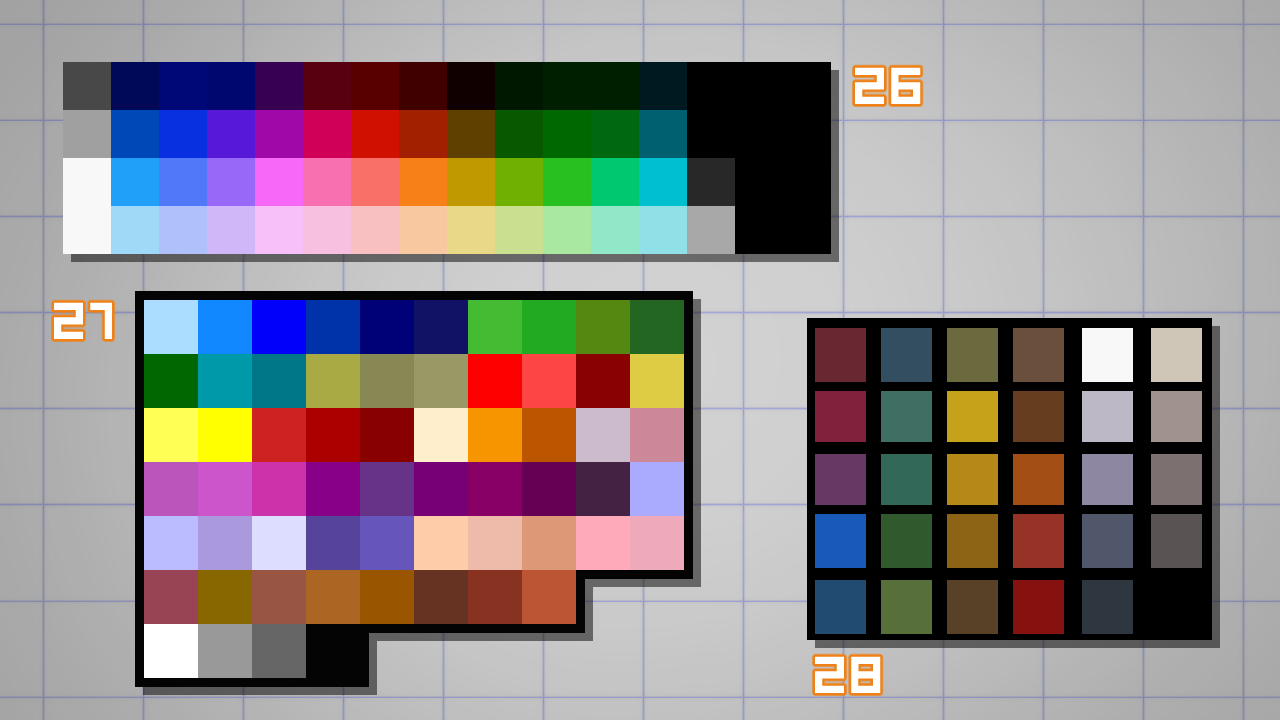
I start by filling my lines with some base colors (flatting).
I'm starting with 5 initial colors, including the blackness linework to paint this portrait (29).
On this stage, retrieve to configure your Auto Select and Fill tools for the pixel art workflow, disabling Expanse Scaling and Anti-aliasing (30).

To shade (add shadows) the peel colour on the portrait, you don't need to simply use the darker value of a specific color;
I tin can potentially utilize whatever color available every bit long the values read correctly.
Here's a tip – Create a new layer on elevation of your layer stack, fill up it with black and fix the layer mode to Color.
Now you can use this layer to cheque the value relationship of your colors (32).
In the case below you lot tin see how I managed to apply the one-time background color (royal) as the shade colour of my brown peel (31). I prefer to get with a black groundwork to salvage ane color…
Again, I don't need to – but I'd like to exercise these limitations imposed by the NES color palette.
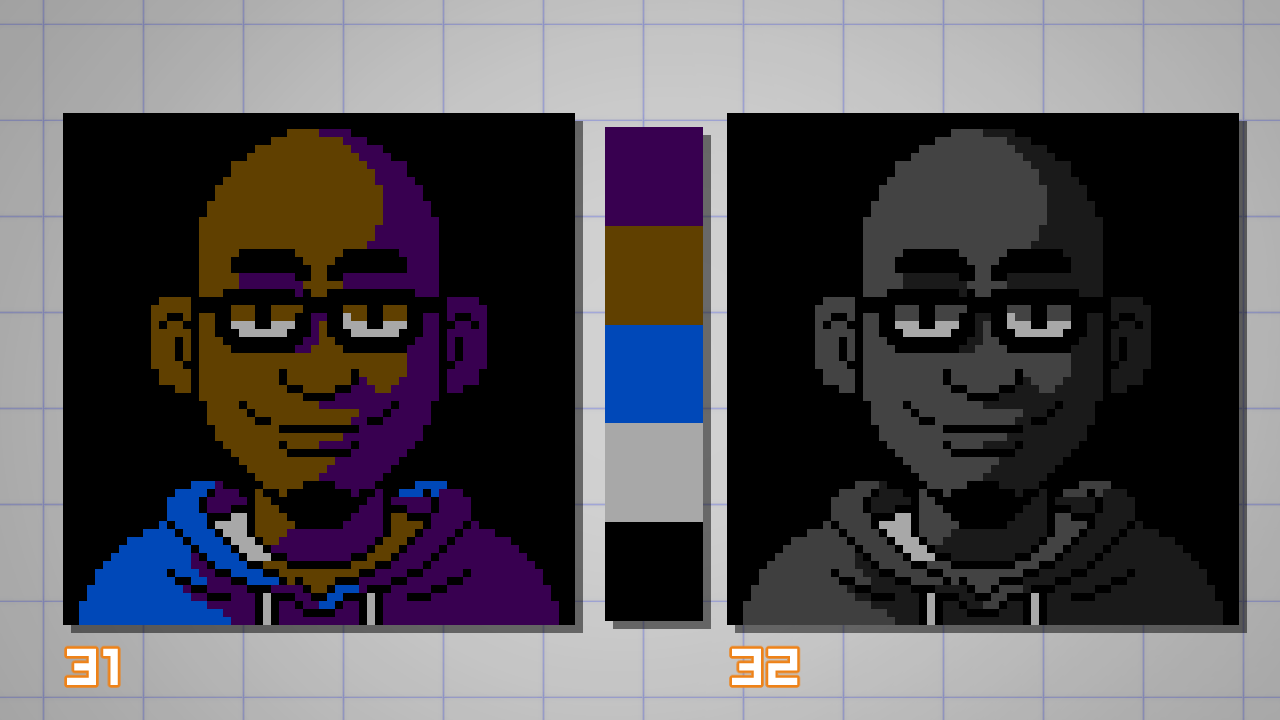
For the highlights on the skin and glasses (33), I don't needed to innovate whatsoever new colors because, while checking the grayscale values (34),
I noticed the colour of the t-shirt could be used for that.
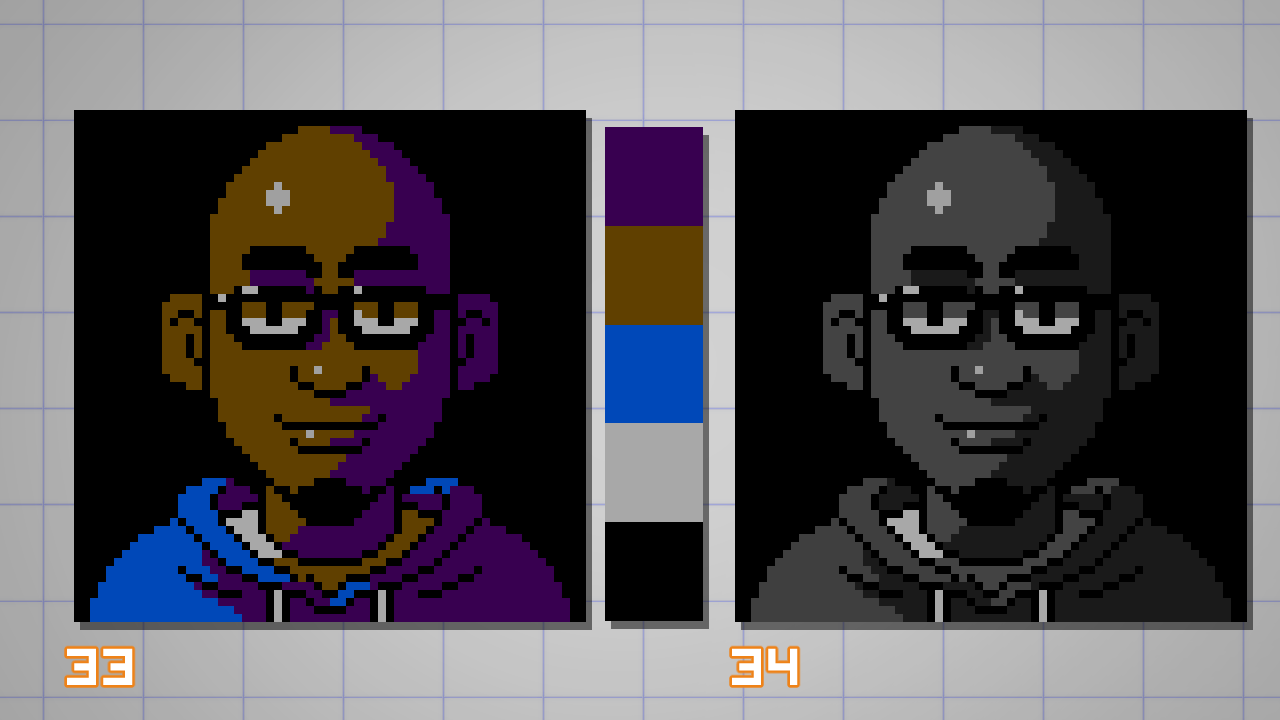
I wanted to add some manual anti-aliasing to smooth the border between the lit and shadowed areas of the skin (36).
Using the NES palette simply, I could non find colors that I could use to create this slope transition.
And so here'southward where I abandoned the 'virtual limitations' in favor of the artwork.
In the example I added two new colours (37), and then I can add more details to the shading.
I can't stress this enough, but it'south actually important that you lot make these decisions while looking the artwork through the existent, non zoomed-in, canvas size (35).
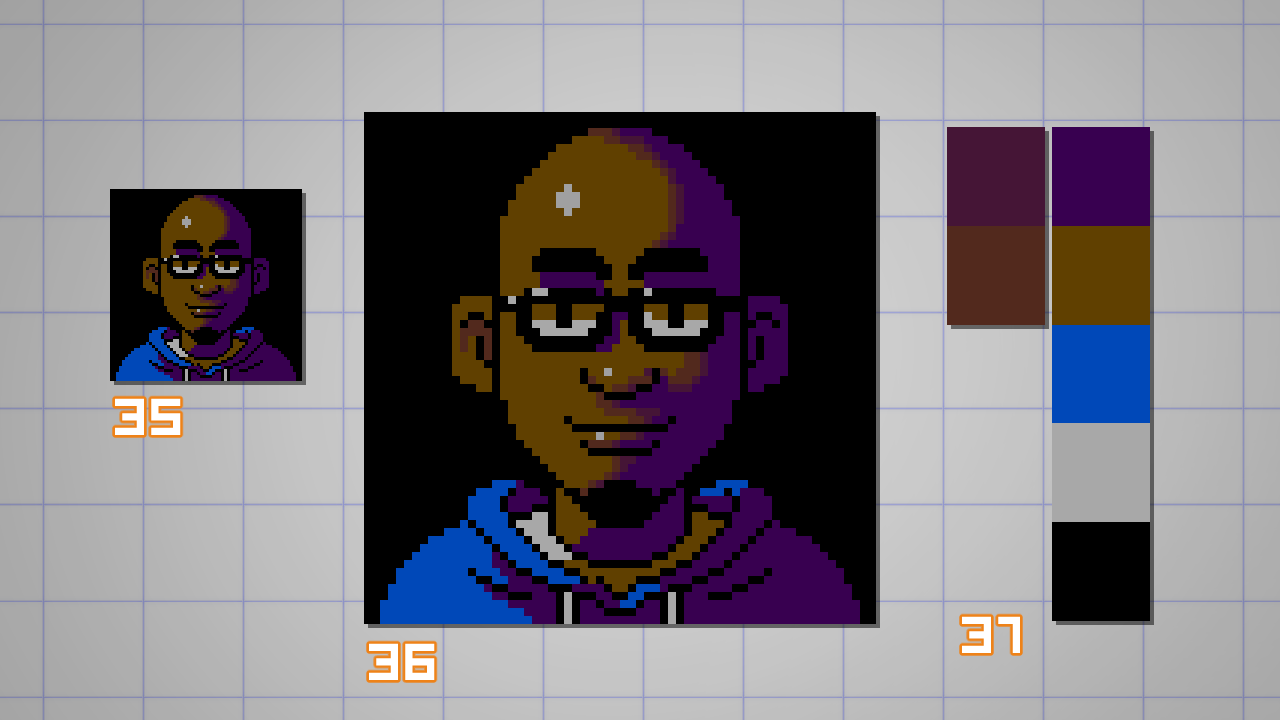
Using the two new extra colors, I increased the rendering on the face adding more than volume, wrinkles ('cause I'1000 getting old) and softening some shadows on the lit side of the portrait (38).
On the bluish jacket, I decided to use the dithering technique to create the sensation of a gradient without adding colors (40).
By breaking upward the solid transitions on a checkerboard pattern I tin make the illusion of an inbetween color (39).
Dithering is an advanced technique and this is just a basic usage for it.
Every bit you lot can come across, the effect creates a textural issue that can be a problem if used on skin or polish surfaces.
I found information technology advisable to use in the jacket (made of cloth), because I tin benefit from the crude texture.
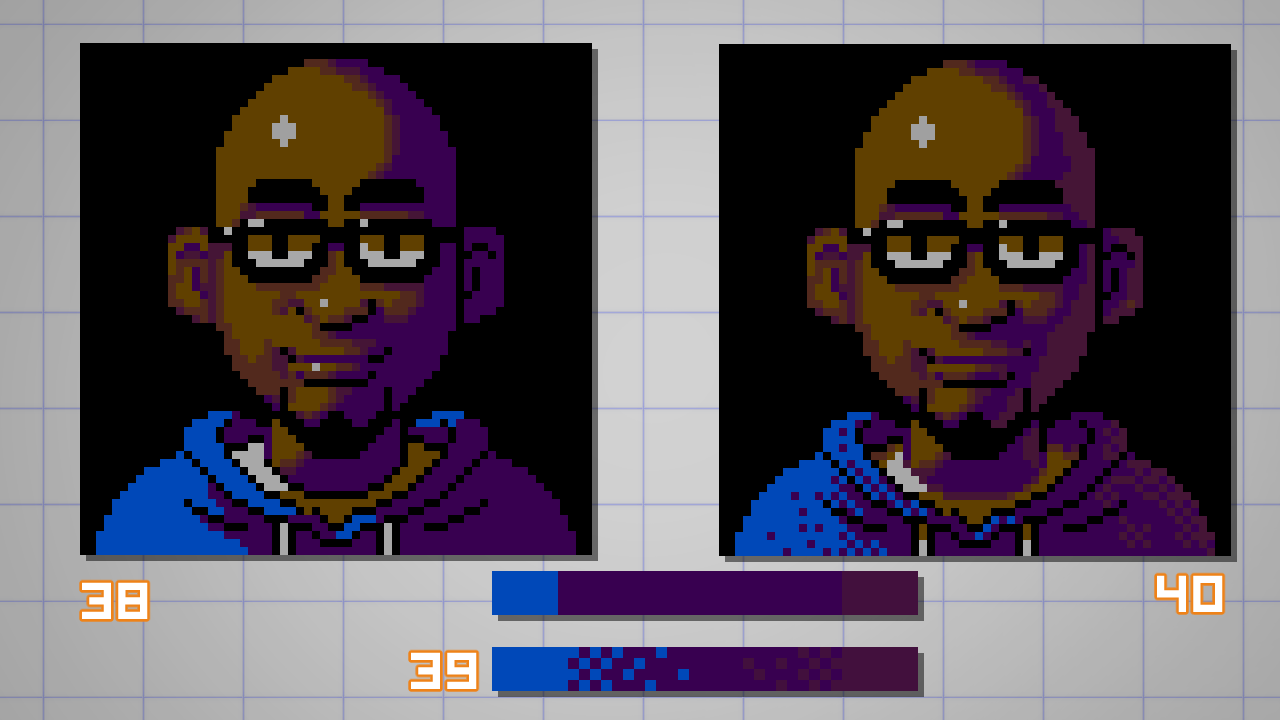
Later some tweaking, I managed to fully paint the portrait.
I'm very happy with the final result because I could fit a lot of details for a 64×64 pixel size artwork with only seven colors.
ps.: I also had pixels and colors enough to prepare those weird-looking cartoony optics. Ten-D
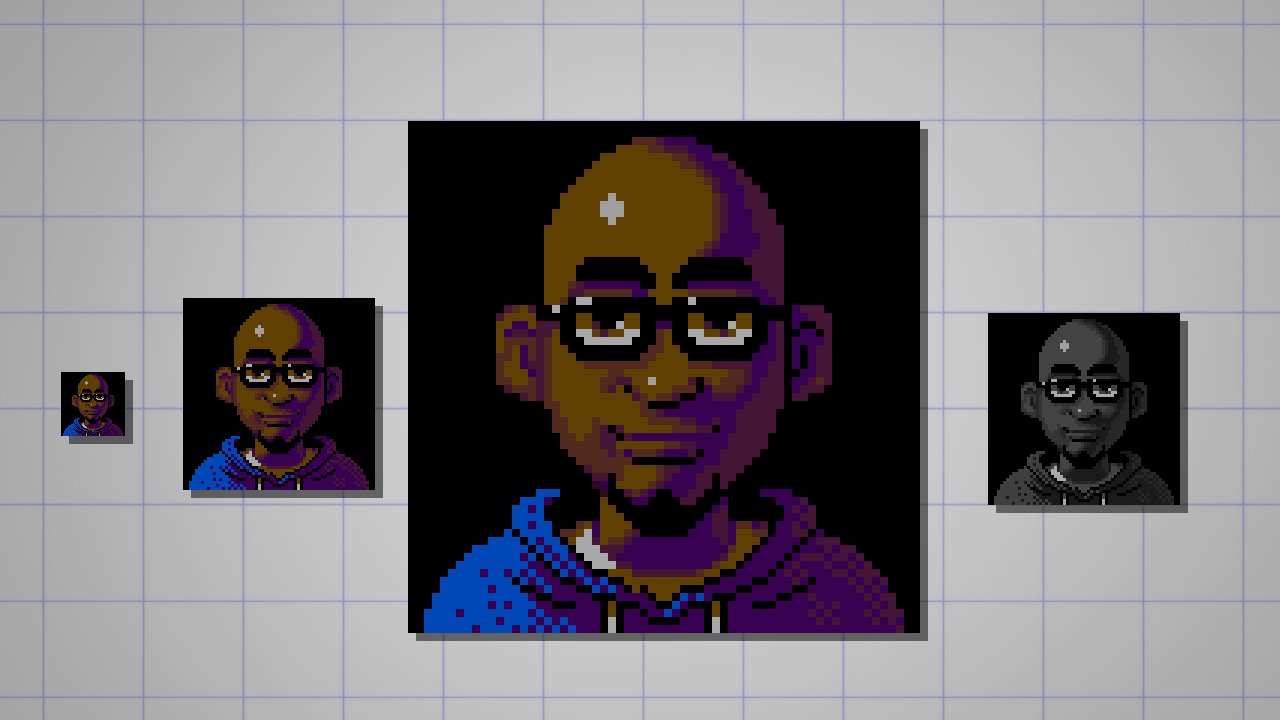
EXPORTING
Terminal, but not to the lowest degree…
When saving and exporting pixel fine art, use the GIF or PNG format.
Avoid using the JPEG format, especially with any level of compression.
This will destroy all the honey and care you used to create your pixel art.
Look at the examples below: a 99% compressed JPEG (41) may wait ok from a altitude, merely it adds some non-wanted colors.
A eighty% compressed version (42) will make whatever pixel creative person bleed. Then please, don't exercise that. 🙂
When it comes to posting on social media, you have to bargain with the automatic-compression of the platform.
For Instagram, you'll have no pick because the system automatically converts and resizes the image to a low-quality jpeg.
On Twitter, you'll have a sharper, about perfect image if the exported file is 506 pixels wide in PNG format.
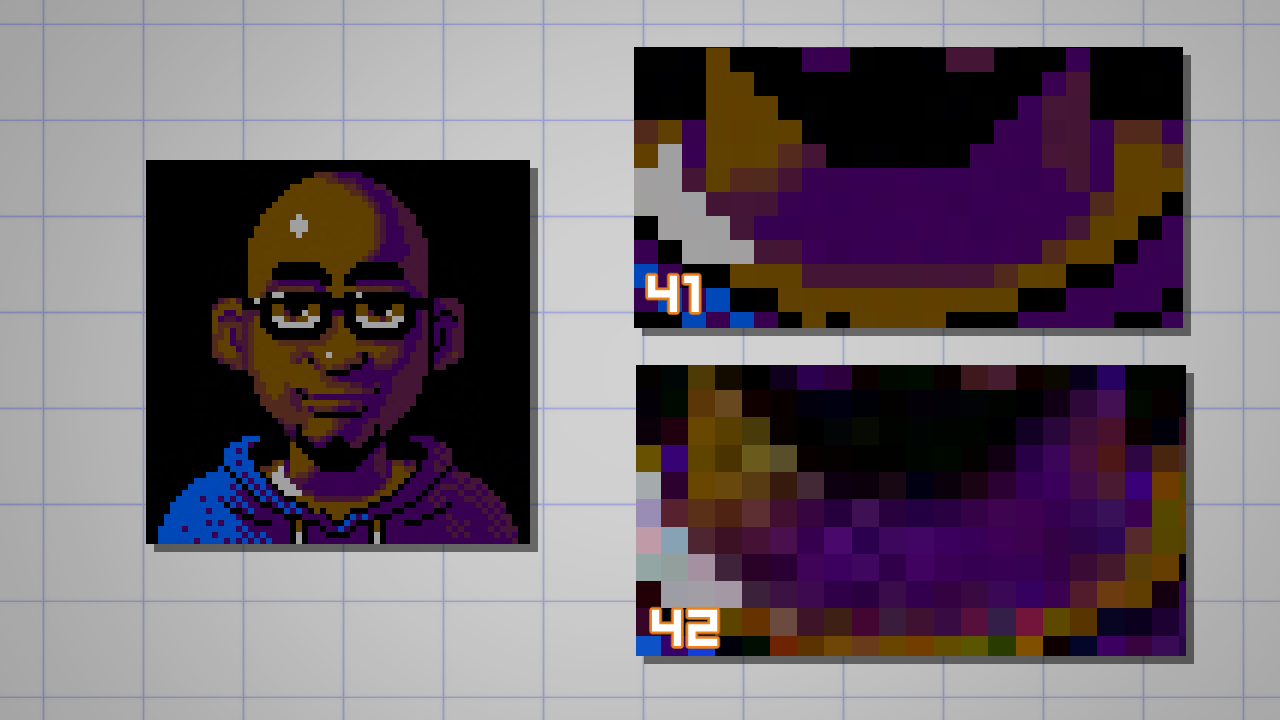
That's it.
I promise you enjoyed this tutorial and also promise you managed to create your showtime pixel fine art portrait.
Below you can discover my minuscule, yet incredible, piece of art. 🙂

If you create yours, delight let me know.
– dado
Artist Profile
Howdy. I'thou Dado (Dadotronic) Almeida and I draw and paint 90'southward-videogame-inspired fine art. As a freelancer artist I create concept and production fine art for games and animation.My indie career is devoted to personal projects similar Claws and Tusks (comic) and artwork that I brand for fun or commissions. I likewise like to teach and share my discoveries nigh digital art, computer graphics, and mental health for artists.
https://www.dadoalmeida.com/
https://twitter.com/dadotronic
https://www.artstation.com/dadotronic
valtierrautmacksmay.blogspot.com
Source: https://www.clipstudio.net/how-to-draw/archives/161082
0 Response to "How to Make Pixel Art in C Visual Studio"
Post a Comment